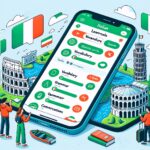Are you planning a trip to Italy and want to be able to communicate with the locals? Learning some Italian language basics for travel can greatly enhance your experience in the beautiful country known for its rich culture, history, and cuisine. Whether you’re exploring the ancient streets of Rome, indulging in pasta in Florence, or admiring the gondolas in Venice, having a good grasp of essential Italian phrases can make your journey more enjoyable and authentic.
From mastering simple greetings to understanding directions and ordering delicious Italian meals, this article will provide you with a comprehensive guide to navigating through Italy with ease. Whether you’re a complete beginner or just looking to brush up on your language skills before your trip, we’ve got you covered.
By familiarizing yourself with key phrases and expressions, you’ll not only be able to communicate more effectively but also connect on a deeper level with the local culture and people.
In addition to practical vocabulary and grammar tips, this article will offer insights into Italian cultural nuances related to language usage. Understanding these cultural aspects can help you avoid misunderstandings and immerse yourself more fully in the Italian way of life. So get ready to embark on an enriching linguistic journey that will not only enhance your travels but also leave you with unforgettable memories of bella Italia.
Pronunciation Guide for Key Italian Phrases
When traveling to Italy, it is essential to have a grasp of the basics of the Italian language. One important aspect to focus on is mastering the pronunciation of key Italian phrases. While Italian pronunciation may seem daunting at first, with some practice, you can easily pick up the correct intonation and accents.
The Italian language is known for its musicality and emphasis on vowels. Unlike English, where pronunciation can vary greatly from word to word, Italian follows more consistent rules for pronunciation. For example, every letter in the Italian alphabet is pronounced, making it easier to sound out words once you learn the basic sounds associated with each letter.
To help you navigate through your travels in Italy smoothly, here are some key phrases along with their proper pronunciations:
- Buongiorno (Good morning): bwon-jor-noh
- Grazie (Thank you): grah-tsyeh
- Dove il bagno? (Where is the bathroom?): doh-veh eel ban-yo
- Quanto costa? (How much does it cost?): kwahn-toh koh-stah
By practicing these phrases and paying attention to pronunciation, you can improve your communication skills and enhance your overall travel experience in Italy.
Remember that locals will appreciate your efforts to speak their language, even if it’s just basic phrases. So don’t be afraid to practice and engage with native speakers during your travels.
Essential Italian Vocabulary for Travel (Greetings, Directions, Food, Etc)
When traveling to Italy, having a good grasp of essential Italian vocabulary can greatly enhance your experience. Whether it’s greeting locals, asking for directions, or ordering food at a restaurant, knowing the basics will not only help you navigate your way around the country but also make interactions with locals more enjoyable. Here are some key Italian phrases and words that every traveler should familiarize themselves with before their trip.
First and foremost, greetings in Italian are crucial in establishing a friendly connection with locals. “Ciao” is a versatile greeting that can be used for both hello and goodbye in informal settings, while “Buongiorno” is used to say good morning and “Buonasera” for good evening. When asking for directions, it’s important to know how to politely approach someone for help. Saying “Scusi” (excuse me) before asking for directions will show respect for the person you’re speaking to.
Furthermore, when dining out in Italy, understanding basic food-related vocabulary is essential. Phrases like “il conto” for the bill or “vino rosso” for red wine can come in handy when ordering meals at restaurants. Learning these common phrases related to greetings, directions, and food will not only make your travel experience smoother but also show locals that you’ve taken the time to learn some Italian language basics for travel.
Common Italian Phrases and Expressions Every Traveler Should Know
Planning a trip to Italy? Knowing some common Italian phrases and expressions can greatly enhance your travel experience. Whether you’re asking for directions, ordering food, or simply greeting locals, having a basic understanding of the Italian language can go a long way in making connections and navigating your way around the country. Here are some essential phrases and expressions every traveler should know:
- Greetings: Start off on the right foot by learning how to greet people in Italian. “Ciao” is a simple and versatile word that can be used to say hello or goodbye in an informal setting.
- Basic Phrases: Be prepared with essential phrases like “per favore” (please), “grazie” (thank you), and “scusi” (excuse me) to show respect and politeness in various situations.
- Ordering Food: When dining out, knowing how to order food is crucial. Use phrases like “vorrei ” (I would like ) when ordering from a menu and “il conto, per favore” (the bill, please) when you’re ready to pay.
In addition to these key phrases, it’s important to familiarize yourself with common expressions that will come in handy during your travels in Italy. Whether you’re shopping at local markets, exploring tourist attractions, or interacting with locals, knowing basic Italian will make your experience more enjoyable and enriching.
- “Dov’è il bagno?” – Where is the bathroom?
- “Quanto costa?” – How much does it cost?
- “Mi scusi, parla inglese?” – Excuse me, do you speak English?
By mastering these common Italian phrases and expressions before your trip, you’ll not only be better equipped to communicate effectively but also show appreciation for the local culture and language. Embrace the opportunity to engage with Italians in their native tongue for a more authentic travel experience.
Tips for Mastering Basic Italian Grammar While Traveling
When traveling to Italy, having a basic understanding of Italian grammar can greatly enhance your experience and interactions with locals. While mastering the intricacies of grammar may seem daunting, there are some tips that can help you navigate the Italian language more effectively.
Learn the Basics of Sentence Structure
Understanding the basic components of Italian sentences can go a long way in forming coherent conversations. Like English, Italian follows a subject-verb-object order in most cases. However, there are certain exceptions and nuances to be aware of. Learning how to construct simple sentences, ask questions, and express needs can make communication smoother during your travels.
Pay Attention to Gender and Number
In Italian, nouns have genders (masculine or feminine) and numbers (singular or plural). It is essential to pay attention to these grammatical features when using adjectives, articles, and pronouns. Familiarizing yourself with common noun endings that indicate gender can help you correctly match articles and adjectives in your speech.
Practice Verb Conjugation
Verbs play a vital role in Italian grammar as they change form according to the subject and tense. Understanding verb conjugation rules for regular and irregular verbs is crucial for expressing actions accurately. Practice common verbs in different tenses such as present, past, future, and imperative forms to communicate effectively while traveling.
By incorporating these tips into your language learning approach, you can improve your grasp of basic Italian grammar while exploring the beautiful sights and sounds of Italy. Remember that making mistakes is part of the learning process, so embrace every opportunity to practice speaking with locals and enhancing your travel experiences through language acquisition.
Useful Resources for Learning Italian Language Basics Before Your Trip
Traveling to Italy can be an amazing experience, but it’s essential to have at least some knowledge of the Italian language basics for travel in order to fully immerse yourself in the culture and communicate effectively with locals. Fortunately, there are a variety of resources available to help you learn the basics of the Italian language before your trip.
Online Language Learning Platforms
One of the most convenient ways to start learning Italian is through online language learning platforms such as Duolingo, Babbel, or Rosetta Stone. These platforms offer interactive lessons that cover everything from basic vocabulary to more advanced grammar concepts. Many of them also have mobile apps, making it easy to practice on the go.
Language Classes or Tutorials
If you prefer a more structured approach to learning Italian, consider taking a language class or hiring a tutor. Many community colleges and language schools offer beginner-level Italian courses that focus on practical conversation skills for travelers. Alternatively, you can find private tutors who specialize in teaching Italian to beginners.
Italian Phrasebooks and Travel Guides
In addition to formal language learning resources, it’s helpful to invest in an Italian phrasebook or travel guide that includes useful phrases and vocabulary specific to travel situations. These pocket-sized books are great for quick reference while you’re navigating a new city or ordering food at a restaurant.
Some even come with audio pronunciations to help you practice speaking Italian correctly. By utilizing these resources before your trip, you’ll be better equipped to handle everyday interactions in Italy with confidence.
Cultural Insights Related to Language Usage in Italy
Italy is a country known for its rich cultural history, art, and culinary delights. When it comes to language usage in Italy, understanding some cultural insights can greatly enhance your travel experience. One key aspect to keep in mind is the importance of greetings in Italian culture.
Italians are known for their warmth and emphasis on formalities when greeting others. “Ciao” may be a popular way to say hello or goodbye among friends, but when meeting someone for the first time or in a more formal setting, “Buongiorno” (good morning) or “Buonasera” (good evening) is more appropriate.
Another cultural aspect to consider is the use of gestures in Italian communication. Italians are known for their expressive hand movements and gestures that often accompany their speech. While verbal communication is essential, understanding these non-verbal cues can help you better connect with locals and navigate social interactions. For example, shaking your head from side to side does not necessarily mean “no” in Italy; it could indicate uncertainty or that you do not have a strong opinion either way.
Furthermore, language plays a significant role in Italian cuisine and dining etiquette. Knowing some basic food-related vocabulary can enhance your dining experience. From ordering at restaurants to shopping at local markets, being able to communicate your preferences or dietary restrictions in Italian can make your culinary adventures even more enjoyable. Additionally, demonstrating an effort to speak the local language shows respect for the culture and can lead to memorable interactions with Italians during your travels.
| Aspect | Insight |
|---|---|
| Greetings | Formalities are valued – use “Buongiorno” or “Buonasera” with new acquaintances. |
| Gestures | Understand expressive hand movements as part of Italian communication. |
| Cuisine | Learn basic food vocabulary for dining experiences and market interactions. |
Real-Life Scenarios and Dialogues to Practice Italian Language Skills While Traveling
One of the best ways to practice and improve your Italian language skills while traveling is by engaging in real-life scenarios and dialogues with locals. Whether you’re ordering food at a restaurant, asking for directions, or simply striking up a conversation with a friendly local, these interactions can greatly enhance your language proficiency.
For example, when you’re at a café or restaurant in Italy, try using basic Italian phrases like “Buongiorno” (good morning), “Grazie” (thank you), or “Posso avere il conto?” (can I have the bill?). By actively participating in these exchanges, you not only improve your language skills but also immerse yourself more fully in the local culture.
Additionally, don’t be afraid to make mistakes. Locals appreciate when travelers make an effort to speak their language, even if it’s not perfect. They are often willing to help and correct you politely. This kind of feedback is invaluable for your learning process and will ultimately make your travel experience more fulfilling.
| Italian Phrase | English Translation |
|---|---|
| “Dov’è la stazione?” | “Where is the train station?” |
| “Quanto costa?” | “How much does it cost?” |
| “Mi scusi “ | “Excuse me “ |
Conclusion
In conclusion, learning basic Italian is truly essential for enhancing your travel experiences in Italy. By familiarizing yourself with key Italian phrases, pronunciation, vocabulary, and grammar, you can navigate through the country with ease and confidence. Whether you are ordering a meal at a local trattoria, asking for directions to iconic landmarks like the Colosseum or the Leaning Tower of Pisa, or simply engaging in conversations with locals, knowing some Italian will undoubtedly enrich your journey.
Moreover, understanding the Italian language opens up doors to the rich cultural heritage of Italy. It allows you to immerse yourself more fully in the art, history, music, and traditions of this beautiful country. Locals will appreciate your efforts to speak their language and will often respond more warmly to you when they see that you are making an effort to communicate in Italian.
So before embarking on your next trip to Italy, take the time to brush up on some Italian language basics for travel. Not only will it make your experience more enjoyable and fulfilling, but it will also show respect for the culture and people of Italy. Remember that communication is key in any travel adventure, so why not make it even more rewarding by adding a touch of the exquisite Italian language to your repertoire?
Start practicing those common phrases and expressions now – “Buon viaggio.” (Have a good trip. ).
Frequently Asked Questions
What Is the Best Way to Learn Italian for Travel?
The best way to learn Italian for travel is to immerse yourself in the language as much as possible. This could involve taking classes, practicing with a language exchange partner, using language learning apps, or even watching Italian movies and TV shows.
It’s essential to practice speaking, listening, reading, and writing in order to become proficient enough to communicate effectively while traveling in Italy.
What Phrases Do I Need to Know in Italy?
When traveling in Italy, it’s helpful to know some basic phrases that will make your experience smoother and more enjoyable. Some key phrases to know include greetings like “buongiorno” (good morning), “per favore” (please), and “grazie” (thank you).
Additionally, knowing how to ask for directions (“Dove si trova…? “), ordering food (“Vorrei…”), and basic conversation starters can also be beneficial during your trip.
Do I Need to Speak Italian to Travel to Italy?
While it is not absolutely necessary to speak Italian when traveling to Italy, having some knowledge of the language can greatly enhance your experience. Many Italians do speak English, especially in tourist areas, but making an effort to communicate in Italian shows respect for the local culture and can lead to more meaningful interactions with locals.
Even just knowing a few key phrases can go a long way in showing that you are trying to connect with the people and culture of Italy.

I’m a passionate traveler, writer, and Italophile. My fascination with Italy’s history, art, and culture has led me on countless adventures across the Italian landscape. Through “I Live Italy,” I share my love for this extraordinary country and aims to inspire others to explore its boundless beauty.





